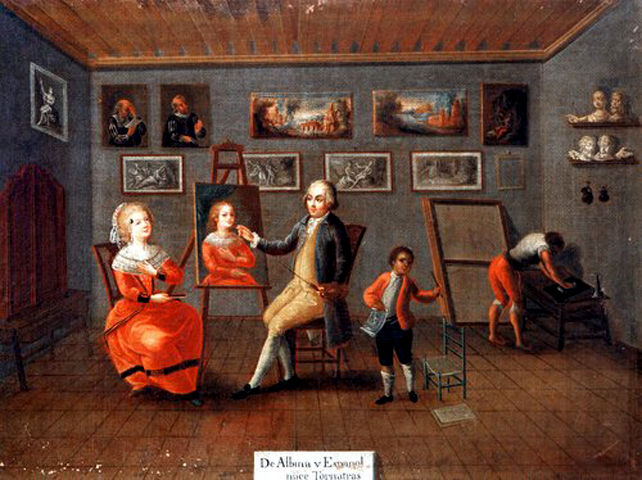Torna Atrás*
After De Albina y Español, Nace Torna Atrás
(From Albino and Spaniard, a Return-Backwards Is Born),
Anonymous. c. 1785-1790
The unknown artist has rendered the father a painter and so
we see him at his work: painting a portrait of his wife —
their dark child watching nearby, a servant grinding colors
in the corner. The woman poses just beyond his canvas
and cannot see her likeness, her less than mirror image coming to life beneath his hand. He has rendered her
homely, so unlike the woman we see in this scene, dressed
in late century fashion, a chicqueador—mark of beauty
in the shape of a crescent moon—affixed to her temple.
If I say his painting is unfinished, that he has yet to make her
beautiful, to match the elegant sweep of her hair,
the graceful tilt of her head, has yet to adorn her dress
with lace and trim, it is only one way to see it. You might see,
instead, that the artist—perhaps to show his own skill—
has made the father a dilettante, incapable of capturing
his wife’s beauty. Or, that he cannot see it: his mind’s eye
reducing her to what he’s made, as if to reveal the illusion
immanent in her flesh. If you consider the century’s mythology
of the body—that a dark spot marked the genitals of anyone
with African blood—you might see how the black moon
on her white face recalls it: the roseta she passes to her child
marking him torna atrás. If I tell you such terms were born
in the Enlightenment’s hallowed rooms, that the wages of empire
is myopia, you might see the father’s vision as desire embodied
in paint, this rendering of his wife born of need to see himself
as architect of Truth, benevolent patriarch, father of uplift
ordering his domain. And you might see why, to understand
my father, I look again and again at this painting: how it is
that a man could love—and so diminish what he loves.
Torna atrás or Tornatrás is a term once used in the Spanish Empire,
colonial Spanish America and the Philippines, to describe a mixed
race person that showed phenotypic characteristics of only one of
the "original races", that is, white, black, Amerindian or Asian. The
term was also used to describe an individual whose parentage was
half white and half “albino".
coming to life beneath his hand. He has rendered her
homely, so unlike the woman we see in this scene, dressed
in late century fashion, a chicqueador—mark of beauty
in the shape of a crescent moon—affixed to her temple.
If I say his painting is unfinished, that he has yet to make her
beautiful, to match the elegant sweep of her hair,
the graceful tilt of her head, has yet to adorn her dress
with lace and trim, it is only one way to see it. You might see,
instead, that the artist—perhaps to show his own skill—
has made the father a dilettante, incapable of capturing
his wife’s beauty. Or, that he cannot see it: his mind’s eye
reducing her to what he’s made, as if to reveal the illusion
immanent in her flesh. If you consider the century’s mythology
of the body—that a dark spot marked the genitals of anyone
with African blood—you might see how the black moon
on her white face recalls it: the roseta she passes to her child
marking him torna atrás. If I tell you such terms were born
in the Enlightenment’s hallowed rooms, that the wages of empire
is myopia, you might see the father’s vision as desire embodied
in paint, this rendering of his wife born of need to see himself
as architect of Truth, benevolent patriarch, father of uplift
ordering his domain. And you might see why, to understand
my father, I look again and again at this painting: how it is
that a man could love—and so diminish what he loves.
Torna atrás or Tornatrás is a term once used in the Spanish Empire,
colonial Spanish America and the Philippines, to describe a mixed
race person that showed phenotypic characteristics of only one of
the "original races", that is, white, black, Amerindian or Asian. The
term was also used to describe an individual whose parentage was
half white and half “albino".